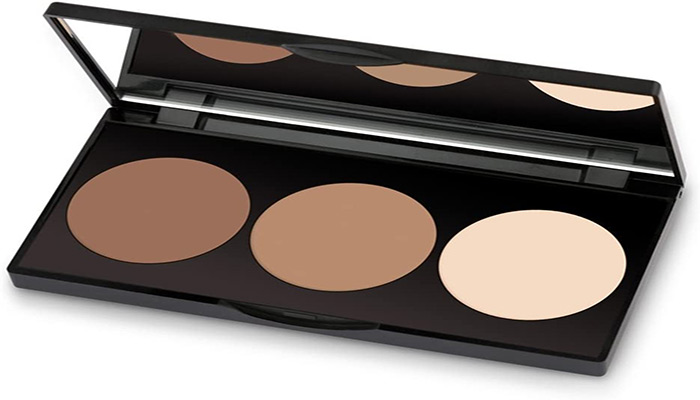What is Contour Palette Powder? Tips to Used on Face

Makeup is the necessary for every girls and women when they are going to any event or party, When we see any girls, Fist our eye sight going on their face, hair, lips, eyes, color then go other body parts, So, Today we are going to talk about another makeup product that called contour palette. This Article about What is Contour palette powder, Types, Benefits and Uses.
What is Contour Palette?
A contour palette is a makeup product that typically contains a selection of shades designed for contouring and highlighting the face. These palettes are versatile and offer a range of colors that can be used to define and enhance various facial features. Contouring involves creating shadows and highlights on specific areas of the face to accentuate its natural structure.
A typical contour palette may include the following components:
- Contour Shades:
- Matte powders or creams that are a few shades darker than your natural skin tone. These are applied to areas where shadows naturally fall, such as the hollows of the cheeks, along the jawline, the sides of the nose, and the hairline.
- Highlight Shades:
- Lighter shades that are used to bring attention to specific areas. These are often applied to the tops of the cheekbones, the bridge of the nose, the cupid’s bow, the brow bone, and sometimes the forehead and chin.
- Bronzer (Optional):
- Some contour palettes may also include a bronzer, which is a warm-toned product used to add warmth and a sun-kissed glow to the skin.
Contour palettes are convenient for makeup enthusiasts and professionals alike because they provide a range of coordinated shades in one compact or palette. This allows users to customize their contouring based on their skin tone, makeup look, and personal preferences.
When using a contour palette, it’s essential to blend the products well to achieve a natural and seamless finish. Different contour palettes cater to various skin tones, so it’s advisable to choose one that complements your complexion. Additionally, some contour palettes are available in cream, powder, or stick formulations, providing users with options based on their preferred texture.
Type of Contour palette
Contour palettes come in various types, and each type offers different formulations and shades to cater to diverse preferences and skin tones. Here are some common types of contour palettes:
Powder Contour Palette:
This type contains powder formulations for both contour and highlight shades. Powder contour palettes are popular for their ease of use and are suitable for a wide range of skin types.
Cream Contour Palette:
Cream contour palettes feature creamy formulations for contouring and highlighting. These are often chosen by those with dry or mature skin, as they provide a dewy finish.
Stick Contour Palette:
Stick contour palettes contain contour and highlight products in stick form. They are convenient for precise application and are travel-friendly.
Multi-Texture Contour Palette:
Some contour palettes include a mix of textures, combining powders, creams, and sometimes even liquids. These versatile palettes cater to different preferences within a single compact.
Matte Contour Palette:
Matte contour palettes contain only matte formulations, excluding any shimmer or glitter. This type is preferred by those who want a more natural, sculpted look without added luminosity.
Shimmer Contour Palette:
Shimmer contour palettes feature products with a subtle shimmer or sheen. These are chosen for a more radiant and luminous finish.
Duochrome Contour Palette:
Duochrome contour palettes contain shades with color-shifting pigments, providing a multi-dimensional effect. These palettes are chosen for a unique and eye-catching finish.
Customizable Contour Palette:
Some brands offer customizable contour palettes, allowing users to select individual pans or shades to create their personalized palette. This type is suitable for those who want complete control over their contour and highlight shades.
Travel-Size Contour Palette:
Travel-size contour palettes are smaller versions of regular palettes, making them ideal for on-the-go touch-ups and travel convenience.
When choosing a contour palette, consider factors such as your preferred formulation (powder, cream, stick), your skin type, and the specific shades that complement your skin tone. Experimenting with different textures and finishes can help you find the contour palette that best suits your makeup routine and style.
Read More – What is Contour makeup
11 Best Contour Palettes and Kits for Sculpting Cheekbones, Jawlines
As of my last knowledge update in January 2022, several contour palettes and kits were highly regarded for sculpting cheekbones and jawlines. Keep in mind that the popularity of beauty products can change, and new releases may have come out since then. Here are 11 contour palettes and kits that were well-received:
Anastasia Beverly Hills Contour Kit:
A classic choice, Anastasia Beverly Hills offers a Contour Kit with a range of matte contour and highlight shades suitable for various skin tones.
Fenty Beauty Match Stix Trio:
Rihanna’s Fenty Beauty Match Stix Trio includes contour, highlight, and concealer sticks for easy sculpting and highlighting.
Kevyn Aucoin The Contour Book:
Kevyn Aucoin’s Contour Book contains a variety of contour powders, highlighters, and eyeshadows, making it a versatile option for face sculpting.
NYX Professional Makeup Highlight & Contour Pro Palette:
NYX’s affordable Highlight & Contour Pro Palette features eight shades to contour and highlight, catering to different skin tones.
Makeup Revolution Ultra Contour Palette:
Known for its affordability and quality, Makeup Revolution’s Ultra Contour Palette includes contour, bronzer, and highlight shades.
Kat Von D Shade + Light Contour Palette:
Kat Von D’s Shade + Light Contour Palette offers three contour shades and three highlight shades in a user-friendly layout, suitable for various face shapes.
NARS Contour Blush:
NARS provides a Contour Blush duo that combines a matte contour shade and a complimentary highlighter for a sculpted look.
Benefit Cosmetics Hoola Matte Bronzer:
While technically a bronzer, Benefit’s Hoola is often used for contouring due to its matte finish and neutral tone.
Huda Beauty Tantour Contour & Bronzer Cream:
Huda Beauty’s Tantour is a cream-to-powder contour product that comes in a variety of shades, offering a sculpted finish.
Too Faced Cocoa Contour Palette:
Too Faced’s Cocoa Contour Palette features four shades, including a chocolate-scented bronzer, to contour and define facial features.
BH Cosmetics Studio Pro Contour Palette:
BH Cosmetics Studio Pro Contour Palette is an affordable option with a range of contour and highlight shades, suitable for different skin tones.
Before purchasing a contour palette, consider your skin tone, undertones, and preferred formulation (powder, cream, or stick). Additionally, check for recent reviews and updates to ensure you’re making an informed decision based on current product performance.
Read More – Best Face Highlighter
Contour palette cream for face
there are various cream contour palettes available, offering different shades and formulations for contouring and highlighting the face. Keep in mind that new products may have been released since then. Here are some cream contour palettes that were well-regarded:
- Anastasia Beverly Hills Cream Contour Kit:
- Anastasia Beverly Hills is known for its contouring products, and the Cream Contour Kit includes a variety of cream shades for contouring and highlighting.
- Fenty Beauty Match Stix Trio:
- Rihanna’s Fenty Beauty offers the Match Stix Trio, featuring cream sticks for contour, highlight, and concealer. The trio is designed for easy sculpting.
- KKW Beauty Crème Contour & Highlight Kit:
- Kim Kardashian’s KKW Beauty line includes the Crème Contour & Highlight Kit, providing cream formulations for sculpting and highlighting.
- NYX Professional Makeup Cream Highlight & Contour Palette:
- NYX’s Cream Highlight & Contour Palette offers a range of cream shades suitable for contouring and highlighting. The creamy texture allows for easy blending.
- Morphe 8H Hi-Fi Sculpt & Shimmer Palette:
- Morphe’s Hi-Fi Sculpt & Shimmer Palette features cream contour and highlight shades, providing a creamy formula for seamless application.
- Benefit Cosmetics Hoola Quickie Contour Stick:
- While not a traditional palette, Benefit’s Hoola Quickie Contour Stick is a cream contour stick that simplifies contouring for a natural look.
- Tom Ford Shade and Illuminate:
- Tom Ford’s Shade and Illuminate is a luxury option that includes a cream contour and highlight duo, offering a sophisticated finish.
- BH Cosmetics Studio Pro Cream Contour Palette:
- BH Cosmetics Studio Pro Cream Contour Palette is a budget-friendly option with multiple cream shades for contouring and highlighting.
Before purchasing a cream contour palette, consider your skin type, undertones, and the specific shades that complement your complexion. Cream contour palettes can provide a more natural and dewy finish compared to powder alternatives. Always check for recent reviews to ensure the product aligns with your preferences and skin needs.
10 Best contour palette powder for face in 2024
There are several contour palettes with powder formulations were well-regarded for sculpting and defining the face. Keep in mind that the popularity of beauty products can change, and new releases may have come out since then. Here are some powder contour palettes that were highly recommended:
- Anastasia Beverly Hills Contour Kit:
- A classic choice, Anastasia Beverly Hills is known for its Contour Kit, offering a range of matte contour and highlight shades suitable for various skin tones.
- Fenty Beauty Match Stix Trio:
- Rihanna’s Fenty Beauty Match Stix Trio includes matte contour and highlight sticks for a customizable and buildable sculpting experience.
- Kat Von D Shade + Light Contour Palette:
- Kat Von D’s Shade + Light Contour Palette features three matte contour shades and three matte highlight shades, designed for different skin tones and undertones.
- NYX Professional Makeup Highlight & Contour Pro Palette:
- NYX’s Highlight & Contour Pro Palette is an affordable option with eight shades, allowing for contouring and highlighting customization.
- Makeup Revolution Ultra Contour Palette:
- Makeup Revolution’s Ultra Contour Palette is known for its affordability and includes a mix of matte contour and highlighting shades.
- Too Faced Cocoa Contour Palette:
- Too Faced offers the Cocoa Contour Palette, featuring four matte shades infused with cocoa powder for a pleasant scent and smooth application.
- NARS Contour Blush:
- NARS Contour Blush Duo includes a matte contour shade and a subtle highlighter, known for its pigmentation and blendability.
- Benefit Cosmetics Hoola Matte Bronzer:
- While technically a bronzer, Benefit’s Hoola Matte Bronzer is often used for contouring due to its neutral tone and matte finish.
- Huda Beauty Tantour Contour & Bronzer Powder:
- Huda Beauty’s Tantour Contour & Bronzer Powder offers a combination of contour and bronzer shades in a buildable powder formula.
- BH Cosmetics Studio Pro Contour Palette:
- BH Cosmetics Studio Pro Contour Palette includes a mix of matte contour and highlighting shades suitable for contouring and defining the face.
Before purchasing a powder contour palette, consider your skin tone, undertones, and the specific shades that suit your complexion. Additionally, check for recent reviews to ensure the product aligns with your preferences and provides the desired sculpting effect.
Follow – https://www.healthcaresutra.com for More Updates



